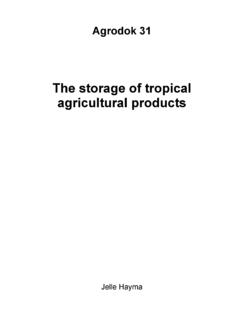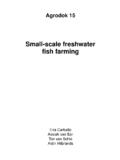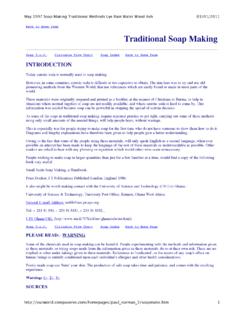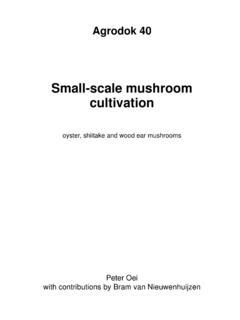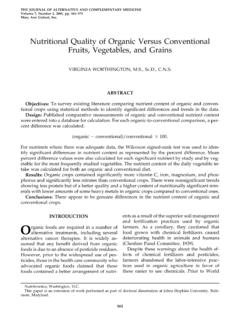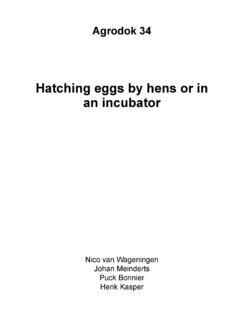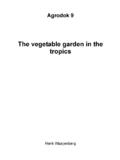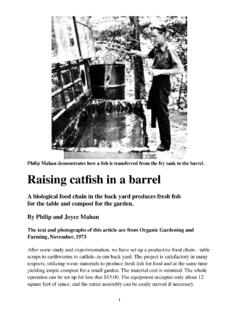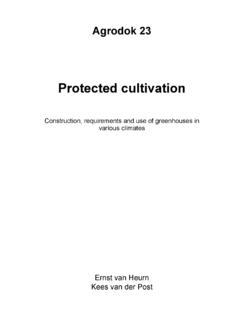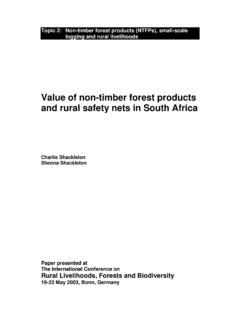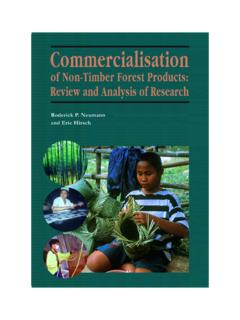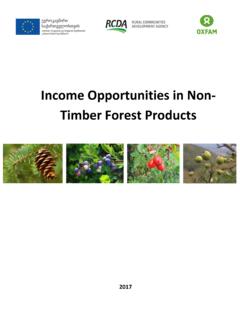Transcription of Agrodok 39 - Journey to Forever
1 Agrodok 39 Non- timber forest products the value of wild plantsTinde van Andel This publication is sponsored by: ICCO, SNV and Tropenbos International Agromisa Foundation and CTA, Wageningen, 2006. All rights reserved. No part of this book may be reproduced in any form, by print, photocopy, microfilm or any other means, without written permission from the publisher. First edition: 2006 Author: Tinde van Andel Illustrator: Bertha Valois V. Design: Eva Kok Translation: Ninette de Zylva (editing) Printed by: Digigrafi, Wageningen, the Netherlands ISBN Agromisa: 90-8573-027-9 ISBN CTA: 92-9081-327-X Foreword 3 ForewordNon- timber forest products (NTFPs) are wild plant and animal pro-ducts harvested from forests, such as wild fruits, vegetables, nuts, edi-ble roots, honey, palm leaves, medicinal plants, poisons and bush meat.
2 Millions of people especially those living in rural areas in de-veloping countries collect these products daily, and many regard selling them as a means of earning a living. This Agrodok presents an overview of the major commercial wild plant products from Africa, the Caribbean and the Pacific. It explains their significance in traditional health care, social and ritual values, and forest conservation. It is designed to serve as a useful source of basic information for local forest dependent communities, especially those who harvest, process and market these products. We also hope that this Agrodok will help arouse the awareness of the potential of NTFPs among development organisations, local NGOs, government officials at local and regional level, and extension workers assisting local communities.
3 Case studies from Cameroon, Ethiopia, Central and South Africa, the Pacific, Colombia and Suriname have been used to help illustrate the various important aspects of commercial NTFP harvesting. Several examples are given of how NGOs can help local communities to im-prove the sustainable harvesting and marketing of wild plant products. Agromisa is grateful to Tropenbos International, ICCO and SNV, who made it possible to publish this Agrodok . I am grateful to Lieselot de Witte and Roy Keijzer (Agromisa) for of-fering me the opportunity to write this booklet. I wish to thank the contributors Norbert Sonn , Maria Paula Balc zar, Hanny van de Lande and Mulugeta Lemenih for their case studies and hope their experiences will serve as an example for other parts of the world.
4 Eva Kok, Ernst van Heurn and Martinus de Kam are thanked for their critical review of the text and Bertha Valois for her beautiful drawings. Tinde van Andel Non- timber forest products 4 Contents1 Introduction 6 2 Importance of NTFPs of plant origin 8 Livelihood of local people 8 International market 10 Traditional health care 11 Social and ritual values 14 Ecological value and forest conservation 16 3 Land ownership and user rights 17 4 Practical aspects of NTFPs 19 Factors related to gathering 19 Environmental impact of NTFP gathering 21 Processing and preserving 23 Transportation and marketing 25 5 Supporting local communities to exploit NTFPs 26 Inventory of local NTFPs 26 Revival of local knowledge 29 Processing and preserving plant products to enhance their value
5 32 Monitoring the market chains 35 Domestication of rare and valuable NTFPs 37 Transport and marketing 40 Organising NTFP harvesters and other relevant stakeholders 43 Ecologically sustainable management 44 Pitfalls and how to avoid them 47 6 Conclusions 49 Appendix 1: Major NTFPs in ACP countries 51 Contents 5 Appendix 2: List of abbreviations 56 Appendix 3: Contributors 57 Appendix 4: Tropenbos International 58 Appendix 5: References 60 Further reading 62 Useful addresses 64 Glossary 67 Non- timber forest products 6 1 IntroductionNon- timber forest products (NTFPs) are wild plant and animal pro-ducts harvested from forests, savannahs and other natural vegetation types.
6 This definition includes the use of wood for canoes, woodcar-vings, local house construction, fencing materials and firewood, but excludes industrial timber . We have decided not to use the term non-wood forest products (NWFPs), often employed by the FAO, because this would exclude the use of wood for dye, poison, craft making and medicine. We also felt the reference to minor forest products to be less appropriate as the local people regard many NTFPs as being more important than industrial wood. Although NTFPs are harvested from the wild, people often gather the seeds of useful plants from the forest and plant them near their homes. These plants are then in the process of domestication. Plants and trees exclusively cultivated in plantations or gardens and no longer col-lected in the wild ( neem tree and potato) are considered to be ag-ricultural products and are not included in this Agrodok .
7 Some impor-tant subjects covered by the definition of NTFPs mentioned above but not dealt with here, such as firewood and bush meat, merit separate publications. In this Agrodok we use the term sustainable use to mean a condition in which people take advantage of the NTFPs in their region, while making sure that care is taken of the plant species that deliver these products and of the environment in which they grow. This helps main-tain the important functions that these plants play in the daily social and economic lives of the local people. We explore and explain the main issues associated with NTFPs, such as subsistence use, commercial use, sustainable and destructive har-vest, transport, marketing, their potential for forest conservation, in-digenous land rights and the loss of traditional knowledge.
8 More spe-cifically, we provide information surrounding the following questions: Introduction 7? What is the importance of non- timber forest products to rural and forest -dwelling communities? ? How can these products increase the income of local people? ? Does harvesting them help to protect the forest ? ? What are the major commercially harvested NTFPs in Africa, the Caribbean and the Pacific? ? How can NGOs and government officials support local initiatives related to NTFPs? ? Can wild plant products be harvested sustainably? ? What are the effects of overharvesting? ? Can certification contribute to sustainable NTFP harvesting and in-creased local income? Case studies from various parts of the world illustrate these issues and provide possible solutions to the main problems associated with NTFP extraction.
9 Particular attention is paid to the potential role of NGOs in the successful commercialisation of products and the development of sustainable management plans. Our objective is to provide civil administrators at local and intermedi-ate level, NGOs working at local and/or regional level and extension supervisors with basic information on the subject. Our focus is on the so-called ACP countries (Africa, Caribbean, Pa-cific). These include all African states, the Caribbean islands including Guyana and Suriname, and the Pacific islands excluding Indonesia and Australia. Within the ACP region, we predominantly focus on Af-rica, since most available information is from that continent. Non- timber forest products 8 2 Importance of NTFPs of plant origin Livelihood of local people Estimates done by the World Health Organisation reveal that 80% of the people living in developing countries use wild plants to meet some of their health and nutritional needs.
10 Thus, billions of people, espe-cially those living in rural areas in developing countries, make use of NTFPs on a daily basis. This involves thousands of plant and tree spe-cies, most of which are consumed within the household of the gather-ers and are not traded in markets. This home-consumption is also called subsistence use . Life would be virtually impossible for most people living in rural areas in developing countries without the avail-ability of palm leaves for roof thatch, medicinal plants and natural fi-bres to construct baskets and fish traps. Many people in these regions have no money to buy zinc sheets for roofing, prescription medicine, construction material or domestic utensils. Moreover, the further away from cities and towns, the higher the transport costs are.
